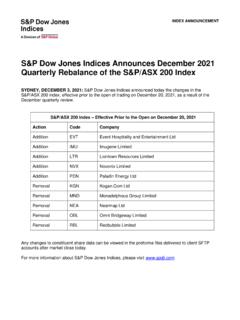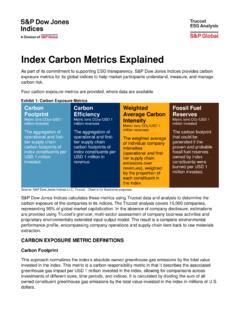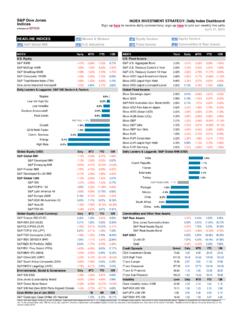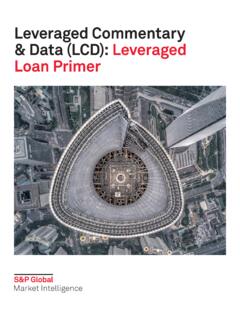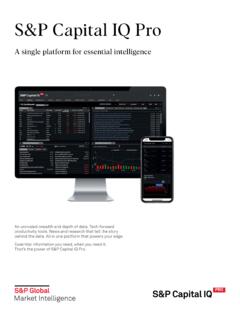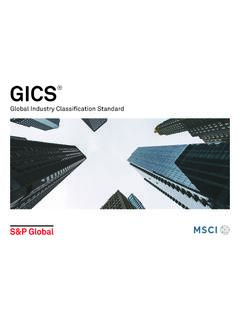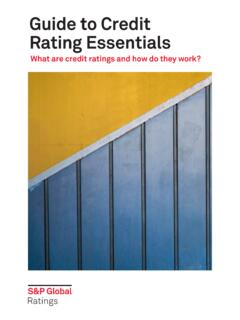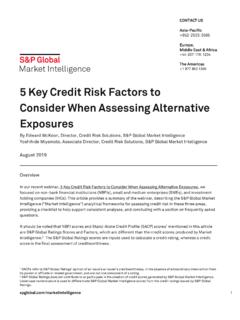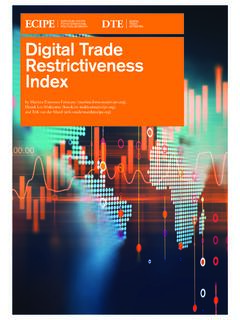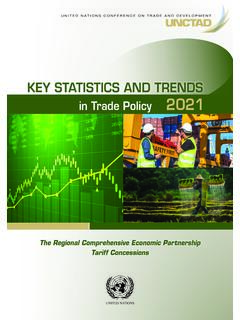Transcription of S&P Paris-Aligned & Climate Transition (PACT) Indices ...
1 S&P Paris-Aligned & Climate Transition (PACT) Indices Methodology March 2023. S&P Dow Jones Indices : index Methodology Table of Contents Introduction 3. index Objective 3. Highlights 3. Climate -Related Data 4. Trucost's Transition Pathway Model 4. Trucost's Physical Risk Data 5. Science Based Target Initiative (SBTI) 5. The S&P DJI ESG Score 6. Supporting Documents 6. Eligibility Criteria 7. index Universe 7. Eligibility Factors 7. index Exclusions 8. Exclusions Based on Business Activities 8. Additional index -Specific Business Activity Exclusions 9.
2 Exclusions Based on Sustainalytics' Global Standards Screening 9. Exclusions Based on Revenue Thresholds in Fossil Fuel Operations and Power Generation 10. Controversies Monitoring: Media and Stakeholder Analysis Overlay 10. Multiple Classes of Stock 11. index Construction 12. Constituent Selection 12. Constituent Weighting 12. Optimization Constraints 12. Constraint Relaxation Hierarchy 15. Constraint-Related Definitions 15. index Calculations 18. index Maintenance 19. Rebalancing 19. Ongoing Maintenance 19. Quarterly Updates 19.
3 Additions and Deletions 19. Corporate Actions 19. S&P Dow Jones Indices : S&P Paris-Aligned & Climate Transition (PACT) Indices Methodology 1. Currency of Calculation and Additional index Return Series 20. Base Dates and History Availability 20. index Data 22. Calculation Return Types 22. index Governance 23. index Committee 23. index Policy 24. Announcements 24. Pro-forma Files 24. Holiday Schedule 24. Rebalancing 24. Unexpected Exchange Closures 24. Recalculation Policy 24. Contact Information 24. index Dissemination 25. Tickers 25.
4 index Data 27. S&P DJI ESG Scores Data 27. Website 27. Appendix I 28. Physical Risk Max Stock Weight Constraint 28. Appendix II 29. C Climate Scenario Transition Pathway Budget index Alignment Constraint 29. Appendix III 31. Methodology Changes 31. Appendix IV 33. index Anchor Date of Decarbonization Trajectory 33. Appendix V 34. Indices in this Methodology Employing Backward Data Assumption 34. Backward Data Assumption 34. Designated Datasets Subject to Backward Data Assumption 35. Historical Coverage Assessment per Designated Dataset 35.
5 Appendix VI 39. EU Required ESG Disclosures 39. Disclaimer 43. Performance Disclosure/Back-Tested Data 43. Intellectual Property Notices/Disclaimer 44. S&P Dow Jones Indices : S&P Paris-Aligned & Climate Transition (PACT) Indices Methodology 2. Introduction index Objective The S&P Net Zero 2050 Climate Transition ESG index Series and S&P Net Zero 2050 Paris-Aligned Climate ESG index Series measure the performance of eligible equity securities from an underlying parent index selected and weighted to be collectively compatible with a C global warming Climate scenario 1 at the index level.
6 The S&P Net Zero 2050 Paris-Aligned Climate ESG index Series encompasses all the elements of the S&P Net Zero 2050 Climate Transition ESG index Series, but are dif ferentiated by their additional restrictiveness and ambition, seen through their additional constraints and eligibility requirements. The Indices apply exclusions based on companies' involvement in specific business activities, violations of the principles of the United Nations' Global Compact (UNGC), and involvement in relevant ESG controversies, all outlined in Eligibility Criteria.
7 Highlights The Indices aim to meet the minimum standards for EU Climate Transition Benchmarks (EU CTBs) and EU Paris-Aligned Benchmarks (EU PABs) under Regulation (EU) 2019/2089 amending Regulation (EU). 2016/10112. The law proposes the definitions of minimum standards for the methodology of any EU. Climate Transition ' and EU Paris-Aligned ' benchmark Indices that would be aligned with the objectives of the Paris Agreement 3, and addresses the risk of greenwashing. The Indices also incorporate factors that seek to manage Transition risk and Climate change opportunities in a way that aligns them with the recommendations of the Financial Stability Board's Task Force on Climate -related Financial Disclosures'.
8 (TCFD) 2017 Final Report 4, covering Transition risk, Climate change opportunities, and, for the S&P Net Zero 2050 Paris-Aligned Climate ESG index Series, stranded asset, and physical risk. Should a material change to the methodology be required as a consequence of any change made by the EU to the minimum standards for EU CTBs and/or EU PABs, S&P Dow Jones Indices will issue an announcement before the change is implemented (and in these circumstances, S&P Dow Jones Indices would not conduct a formal consultation). For clarity, any other methodology change will follow S&P Dow Jones Indices ' standard processes, which may include a consultation.
9 Both index series' weighting strategies aim to minimize the difference in constituent weights to the underlying parent index . In addition, the Indices incorporate a variety of specified decarbonization targets and align with certain specified criteria through the use of optimization with multiple model constraints, including: alignment to a C Climate scenario using Trucost's Transition Pathway Model reduced overall greenhouse gas (GHG expressed in CO2 equivalents) emissions intensity compared to their respective underlying parent index by at least 30% and 50% for the S&P Net Zero 2050 Climate Transition ESG index Series and S&P Net Zero 2050 Paris-Aligned Climate ESG index Series respectively 1.
10 A Climate scenario of C above preindustrial levels has been deemed important by the IPCC: Masson -Delmotte, V., Zhai, P., P rtner, H. O., Roberts, D., Skea, J., Shukla, P. R. Waterfield, T. (2018). Global warming of C. An IPCC Special Report o n the impacts of global warming of C. IPCC, available at 2. Pursuant to Articles 19(a)(2) and 19(b)(1) of Regulation (EU) 2019/2089, Commission Delegated Regulation (EU) 2020/1818 lays down the minimum standards for EU CTBs and EU PABs content/EN/TXT/?uri=CELEX:32020R1818. 3. UNFCCC. (2015).
